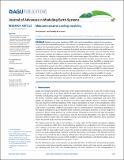| dc.contributor.author | Beucler, Tom G. | |
| dc.contributor.author | Cronin, Timothy Wallace | |
| dc.date.accessioned | 2018-03-29T14:32:21Z | |
| dc.date.available | 2018-03-29T14:32:21Z | |
| dc.date.issued | 2016-10 | |
| dc.date.submitted | 2016-09 | |
| dc.identifier.issn | 19422466 | |
| dc.identifier.issn | 1942-2466 | |
| dc.identifier.uri | http://hdl.handle.net/1721.1/114439 | |
| dc.description.abstract | Radiative‐convective equilibrium (RCE)—the statistical equilibrium state of the atmosphere where convection and radiation interact in the absence of lateral transport—is widely used as a basic‐state model of the tropical atmosphere. The possibility that RCE may be unstable to development of large‐scale circulation has been raised by recent modeling, theoretical, and observational studies, and could have profound consequences for our understanding of tropical meteorology and climate. Here, we study the interaction between moisture and radiative cooling as a contributor to instability of RCE. We focus on whether the total atmospheric radiative cooling decreases with column water vapor; this condition, which we call moisture‐radiative cooling instability (MRCI), provides the potential for unstable growth of moist or dry perturbations. Analytic solutions to the gray‐gas radiative transfer equations show that MRCI is satisfied when the total column optical depth—linked to column water vapor—exceeds a critical threshold. Both the threshold and the growth rate of the instability depend strongly on the shape of the water vapor perturbation. Calculations with a realistic radiative transfer model confirm the existence of MRCI for typical tropical values of column water vapor, but show even stronger dependence on the vertical structure of water vapor perturbation. Finally, we analyze the sensitivity of atmospheric radiative cooling to variability in column water vapor in observed tropical soundings. We find that clear‐sky MRCI is satisfied across a range of locations and seasons in the real tropical atmosphere, with a partial growth rate of ∼1 month. | en_US |
| dc.description.sponsorship | Neil & Anna Rasmussen Foundation | en_US |
| dc.description.sponsorship | National Science Foundation (U.S.) (Grant AGS1136480) | en_US |
| dc.description.sponsorship | Strategic Environmental Research and Development Program (U.S.) (Grant RC-2336) | en_US |
| dc.description.sponsorship | United States. National Oceanic and Atmospheric Administration (Climate and Global Change Postdoctoral Fellowship) | en_US |
| dc.description.sponsorship | Harvard University. Center for the Environment | en_US |
| dc.language.iso | en_US | |
| dc.publisher | American Geophysical Union (AGU) | en_US |
| dc.relation.isversionof | http://dx.doi.org/10.1002/2016MS000763 | en_US |
| dc.rights | Article is made available in accordance with the publisher's policy and may be subject to US copyright law. Please refer to the publisher's site for terms of use. | en_US |
| dc.source | Beucler | en_US |
| dc.title | Moisture-radiative cooling instability | en_US |
| dc.type | Article | en_US |
| dc.identifier.citation | Beucler, Tom, and Timothy W. Cronin. “Moisture-Radiative Cooling Instability.” Journal of Advances in Modeling Earth Systems 8, no. 4 (October 11, 2016): 1620–1640. © 2016 The Authors | en_US |
| dc.contributor.department | Massachusetts Institute of Technology. Department of Earth, Atmospheric, and Planetary Sciences | en_US |
| dc.contributor.approver | Beucler, Tom | en_US |
| dc.contributor.mitauthor | Beucler, Tom G. | |
| dc.contributor.mitauthor | Cronin, Timothy Wallace | |
| dc.relation.journal | Journal of Advances in Modeling Earth Systems | en_US |
| dc.eprint.version | Final published version | en_US |
| dc.type.uri | http://purl.org/eprint/type/JournalArticle | en_US |
| eprint.status | http://purl.org/eprint/status/PeerReviewed | en_US |
| dspace.orderedauthors | Beucler, Tom; Cronin, Timothy W. | en_US |
| dspace.embargo.terms | N | en_US |
| dc.identifier.orcid | https://orcid.org/0000-0002-5731-1040 | |
| dc.identifier.orcid | https://orcid.org/0000-0002-7807-2878 | |
| mit.license | PUBLISHER_POLICY | en_US |
